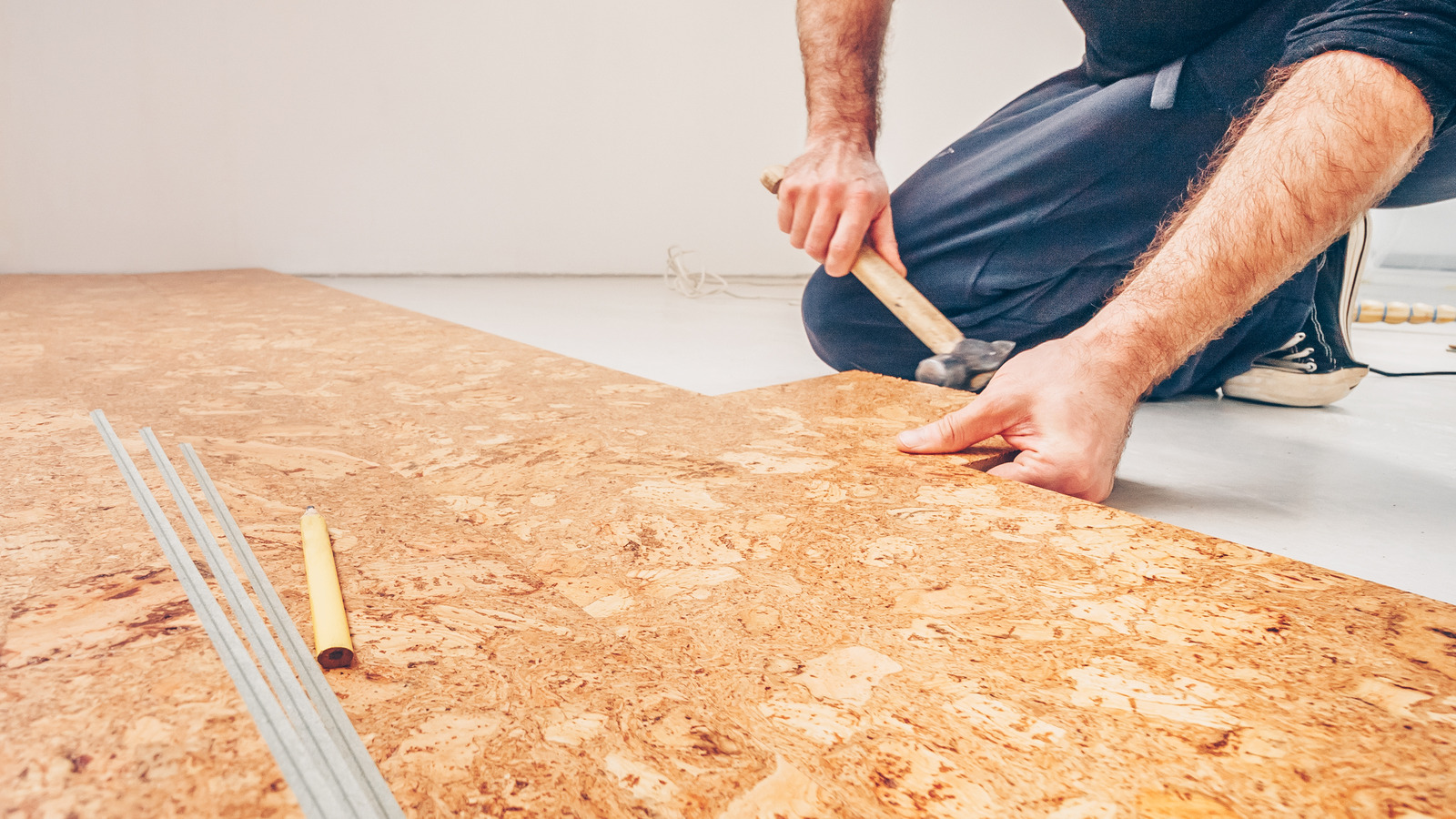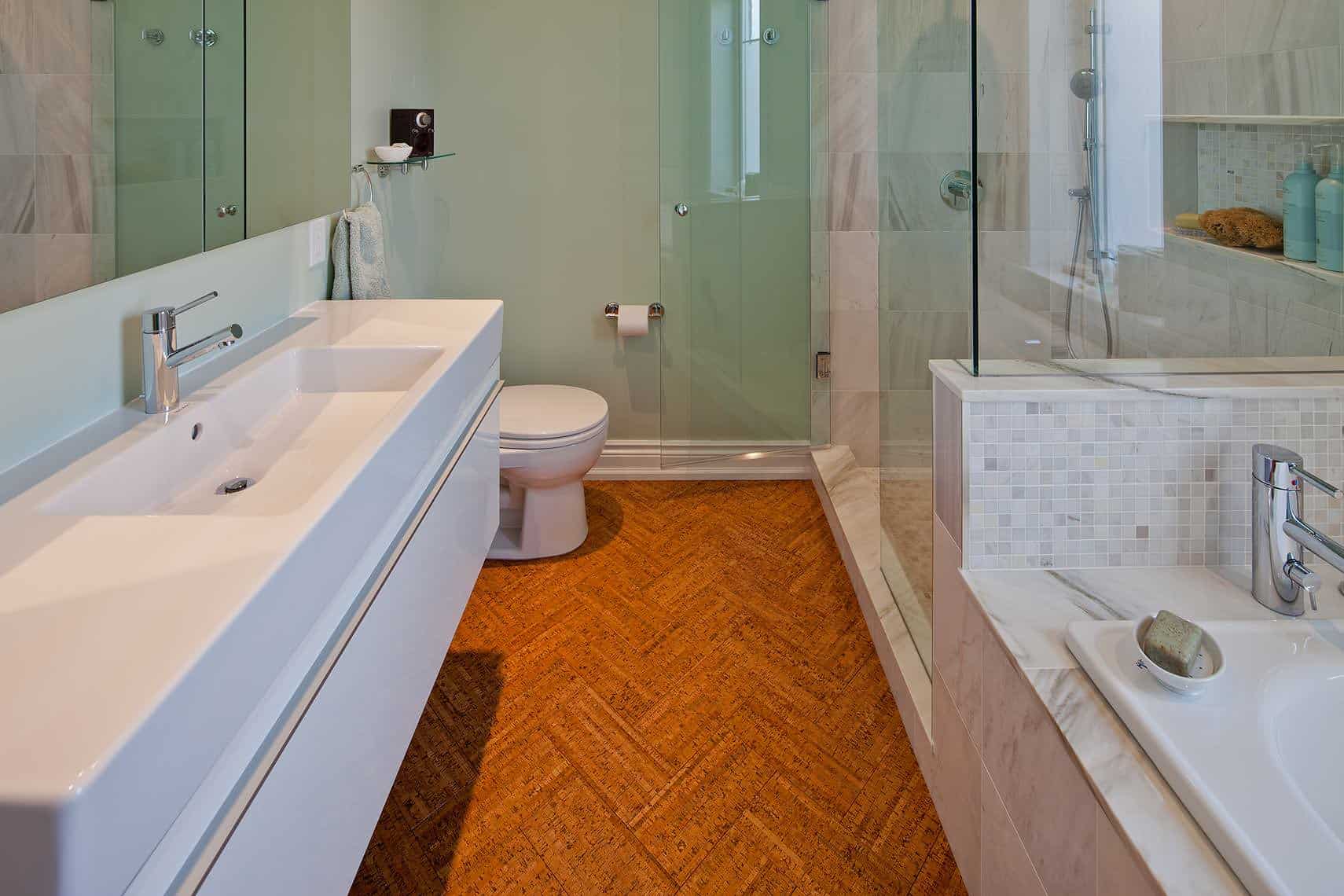Preparing the Bathroom for Cork Flooring Installation: How To Install Cork Flooring In A Bathroom

A clean and dry bathroom floor is essential for a successful cork flooring installation. Cork is a natural material that can be susceptible to moisture damage, so it’s important to ensure that the subfloor is properly prepared before you begin installation.
Removing Existing Flooring
Before installing cork flooring, you’ll need to remove any existing flooring. This may involve removing tile, vinyl, or wood flooring. If you’re removing tile, you’ll need to use a hammer and chisel to break the tiles. If you’re removing vinyl flooring, you can use a utility knife to cut the flooring into smaller pieces. Once the flooring is removed, you’ll need to clean the subfloor thoroughly.
Preparing the Subfloor
Once the existing flooring is removed, you’ll need to inspect the subfloor for any damage. If you find any cracks, holes, or unevenness, you’ll need to repair them before installing the cork flooring. You can use wood filler to fill in any cracks or holes. If the subfloor is uneven, you can use a self-leveling compound to create a smooth surface.
Installing a Moisture Barrier
Cork flooring is susceptible to moisture damage, so it’s important to install a moisture barrier before you begin installation. A moisture barrier will help to prevent moisture from penetrating the subfloor and damaging the cork flooring. You can use a polyethylene sheet or a moisture-resistant underlayment as a moisture barrier. The moisture barrier should be installed over the entire subfloor and should extend up the walls at least 6 inches.
Choosing the Right Adhesive
The type of adhesive you use for cork flooring will depend on the type of subfloor you have and the level of moisture in the bathroom. If you have a concrete subfloor, you’ll need to use a moisture-resistant adhesive. If you have a wood subfloor, you can use a standard cork flooring adhesive.
When choosing an adhesive, it’s important to read the manufacturer’s instructions carefully to ensure that the adhesive is compatible with your subfloor and cork flooring.
Installing the Cork Flooring

Installing cork flooring in a bathroom requires careful consideration of the installation method to ensure durability and water resistance. Different methods offer unique advantages and disadvantages, influencing the overall outcome of your bathroom flooring project.
Cork Flooring Installation Methods, How to install cork flooring in a bathroom
Choosing the right installation method is crucial for a successful cork flooring project in a bathroom. Each method presents distinct pros and cons, impacting the longevity and performance of the flooring.
- Floating Installation: This method involves interlocking cork tiles or planks without using adhesives. The planks are typically equipped with a tongue-and-groove system, allowing them to click together and form a floating floor. Floating installation is known for its ease of installation and ability to expand and contract with changes in temperature and humidity, minimizing warping and buckling. However, it may not be as water-resistant as other methods, requiring additional waterproofing measures.
- Glue-Down Installation: This method involves securing cork tiles or planks to the subfloor using a specialized adhesive. Glue-down installation provides a strong bond, ensuring a stable and durable floor. It offers excellent water resistance, making it suitable for bathrooms. However, it requires more time and effort to install, and removing the flooring in the future can be challenging.
- Click-Lock Installation: This method uses a system of interlocking planks with a click-lock mechanism. It offers the ease of installation of floating floors while providing greater stability and water resistance. The planks snap together, creating a secure and durable floor. However, it may be slightly more expensive than floating installation.
Comparing Cork Flooring Installation Methods
A comparison table helps visualize the advantages and disadvantages of each cork flooring installation method in a bathroom:
| Installation Method | Advantages | Disadvantages |
|---|---|---|
| Floating | Easy installation, adaptable to temperature changes, cost-effective | May require additional waterproofing, less stable than other methods |
| Glue-Down | Strong bond, excellent water resistance, durable | Requires more time and effort to install, difficult to remove later |
| Click-Lock | Ease of installation, greater stability, water resistance | Slightly more expensive than floating installation |
Installing Cork Flooring Using Each Method
Installing cork flooring requires specific steps for each method. Here’s a detailed guide for each:
Floating Installation
- Prepare the Subfloor: Ensure the subfloor is level, clean, and dry. Any imperfections or unevenness can affect the installation and lead to problems later.
- Install a Moisture Barrier: In a bathroom, a moisture barrier is crucial to prevent water damage. Use a waterproof membrane or vapor barrier beneath the cork flooring.
- Lay the First Row: Start by laying the first row of cork planks along the longest wall. Use a spacer to maintain a consistent gap between the planks and the wall.
- Interlock the Planks: Interlock the subsequent planks with the first row, ensuring the tongue and groove system aligns properly.
- Continue Installation: Continue laying the planks in rows, working your way across the bathroom.
- Trim and Cut: Use a utility knife or saw to trim the planks to fit around obstacles and corners.
- Install Transition Strips: If transitioning to another flooring type, install transition strips to create a smooth transition.
- Secure the Flooring: Secure the cork flooring using T-molding or quarter-round molding along the perimeter of the bathroom.
Glue-Down Installation
- Prepare the Subfloor: Ensure the subfloor is level, clean, and dry. Any imperfections or unevenness can affect the installation and lead to problems later.
- Install a Moisture Barrier: A moisture barrier is essential to prevent water damage. Use a waterproof membrane or vapor barrier beneath the cork flooring.
- Apply Adhesive: Apply a thin, even layer of adhesive to the subfloor using a notched trowel.
- Lay the First Row: Start by laying the first row of cork planks along the longest wall. Press the planks firmly into the adhesive.
- Continue Installation: Continue laying the planks in rows, working your way across the bathroom.
- Trim and Cut: Use a utility knife or saw to trim the planks to fit around obstacles and corners.
- Install Transition Strips: If transitioning to another flooring type, install transition strips to create a smooth transition.
- Allow Adhesive to Cure: Allow the adhesive to cure completely according to the manufacturer’s instructions.
Click-Lock Installation
- Prepare the Subfloor: Ensure the subfloor is level, clean, and dry. Any imperfections or unevenness can affect the installation and lead to problems later.
- Install a Moisture Barrier: A moisture barrier is essential to prevent water damage. Use a waterproof membrane or vapor barrier beneath the cork flooring.
- Lay the First Row: Start by laying the first row of cork planks along the longest wall. Use a spacer to maintain a consistent gap between the planks and the wall.
- Interlock the Planks: Interlock the subsequent planks with the first row, ensuring the click-lock mechanism engages properly.
- Continue Installation: Continue laying the planks in rows, working your way across the bathroom.
- Trim and Cut: Use a utility knife or saw to trim the planks to fit around obstacles and corners.
- Install Transition Strips: If transitioning to another flooring type, install transition strips to create a smooth transition.
- Secure the Flooring: Secure the cork flooring using T-molding or quarter-round molding along the perimeter of the bathroom.
Finishing Touches and Maintenance

Your cork flooring is installed, and your bathroom is looking fantastic! But the job isn’t quite finished. To ensure your cork flooring remains beautiful and functional for years to come, you need to seal it properly. Sealing your cork flooring in a bathroom is crucial because it protects the cork from moisture, which can cause damage and shorten its lifespan.
Sealing Cork Flooring
Sealing cork flooring is an essential step in its installation, especially in a bathroom environment. It creates a protective barrier against moisture, preventing water from penetrating the cork and causing damage.
- Water-based polyurethane sealant: This type of sealant is environmentally friendly and dries quickly, making it a popular choice for homeowners. It offers excellent protection against moisture and stains, and it can be applied in multiple coats for added durability.
- Oil-based polyurethane sealant: This sealant is known for its durability and resistance to wear and tear. It provides a high-gloss finish and is often used in high-traffic areas. However, it can take longer to dry and may emit strong fumes.
- Acrylic sealant: This sealant is a good option for those seeking a more natural look. It dries quickly and is easy to apply, but it may not offer the same level of protection as polyurethane sealants.
Applying sealant to your cork flooring is a straightforward process. Here’s a step-by-step guide:
- Prepare the surface: Ensure your cork flooring is clean and free of debris. Use a vacuum cleaner or a damp cloth to remove any dust or dirt.
- Apply the sealant: Use a brush or roller to apply a thin, even coat of sealant to the cork flooring. Be sure to work in small sections to avoid streaks.
- Allow the sealant to dry: Follow the manufacturer’s instructions for drying time. Most sealants require at least 24 hours to cure completely.
- Apply additional coats: For added protection, you can apply a second or third coat of sealant. Be sure to allow each coat to dry completely before applying the next.
Maintaining Cork Flooring
Maintaining cork flooring in a bathroom is relatively easy. Here are some tips:
- Sweep or vacuum regularly: Remove dirt and debris to prevent scratches and wear.
- Clean spills immediately: Wipe up spills with a damp cloth to prevent staining.
- Use a mild cleaner: For deep cleaning, use a pH-neutral cleaner specifically designed for cork flooring. Avoid harsh chemicals or abrasive cleaners.
- Protect from direct sunlight: Excessive sunlight can fade the color of cork flooring. Use curtains or blinds to minimize exposure.
- Reapply sealant periodically: To maintain the protective barrier, reapply sealant every 1-2 years, or as needed, depending on the wear and tear.
